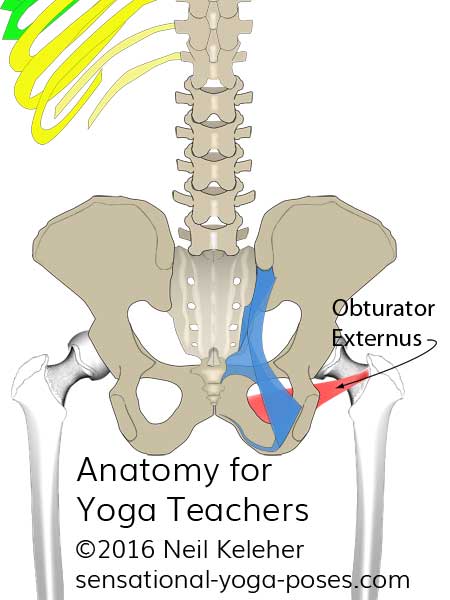Obturator Externus
Anatomy for Yoga Teachers
Does one of your hips feel weak or painful while doing forward bends making it difficult to both enter and leave the pose?
It may be because your brain is not turning on your obturator externus. Following are some tips for how to get your brain to turn it back on again.
Obturator Externus, One of the Deep Six
The obturator externus is one of the six deep muscles of the hip. In an upright position it can be used to help lift the pelvis relative to the thigh. The amount of lift is slight but perceivable via muscle tension.
In combination with the obturator internus and the gemelli, tension in the obturator externus can help prevent the top of the hip joint from resting on the top of the ball of the femur. Excessive tension on any of these muscles can cause the bottom of the hip joint to press up against the bottom of the ball of the thigh.
Keeping the Hip Joint Centered
In a Variety of Circumstances
One way to view the muscles of the hip is as a series of spokes (bicycle wheel spokes) that help to keep the ball of the femur centered relative to the socket of the pelvis. Tension in the muscles is adjusted to counter body weight and the action of the muscles themselves as they are used to change position or movement.
Muscle tension also affects the joint capsule envelope which in turn controls fluid pressure within the capsule which maintains "adjustability" between the ball and socket of the hip joint.
Obturator Externus Anatomy Points
The obturator externus gets its name from the fact that it covers one side of the opening at the bottom of the side of the pelvis, the obturator foramen. It has a large line of attachment that almost spans the bottom of the pelvis from pubic bone to sitting bone. It's fibers pass backwards and upwards behind the neck of the femur to attach to a point on the inner surface of the greater trochanter.
Because of its broad attachment it can extert an upwards (and rearwards) pull on the entire bottom edge of the hip bone.
A muscle with a similiar line of attachment but attaching to most of the length of the back of the femur is the adductor magnus.
The gluteus medius and minimus both attach to the upper edge of the side of the pelvis above the hip joint and from there attach to the outer surface of the greater trochanter. Both of these glutes and the adductor magnus can exert a downwards pull on the pelvis relative to the thigh. Without the weight of the body to contend with either of these muscles could act against the obturator externus to help keep the hip joint centered.
Obturator Externus Function
Forward bending the hip tends to reduce the distance that the obturator externus spans, potentially reducing its tension and its effectiveness. If the hip is bent forwards it may mean that if activated effort is concentrated on the longer fibers that attach closer to the front of the pelvis.
In a forward bent position these fibers could be used to pull the pelvis rearwards relative to the femurs or, from another perspective, pull the femurs forward relative to the pelvis.
This could help keep the hip joint centered in a forward bend.
Back bending at the hip may naturally add tension to the obturator externus. However, externally rotating the thighs may help to reduce some of this tension.
In a back bend for the hip the fibers that attach closer to the front of the pelvis will be stretched. The more rearward fibers may thus be more effective in a back bend helping to create an upward pull on the sitting bones relative to the femurs.
The Obutator Externus, Hip Pain and Weak Hips
For myself I've experienced hip pain in my left hip on and off for a while. It can be quite extreme entereing and leaving forward bends, particular triangle forward bend with the left leg forwards, and also one legged forward bends where the right leg is lifted but pulled forwards. The pain is accompanied by a sense of weakness in the hip.
Recently I've played with deliberately activating obturator externus by pushing back on the pubic bone relative to the hip joint. A potential tip that it is this muscle that is activating when i do this is that the glute med and min also activate.
The trick then is maintaining the activation when entering and leaving the position.
For more on learning to activate the obturator externus, and other muscles of the hip and thigh, check out Sensational Leg Anatomy. It includes exercises for learning to feel and control the muscles of your legs an hips, as well as knees and ankles. It teaches you how to directly experience your leg anatomy.
Published: 2020 08 04



